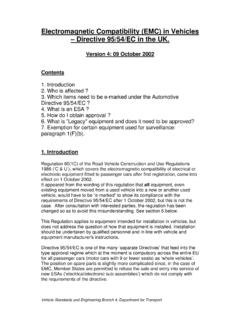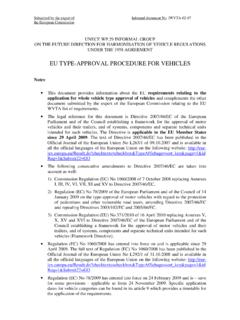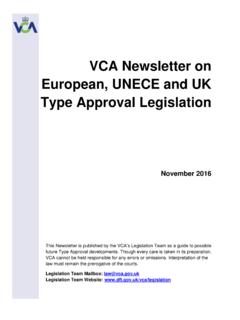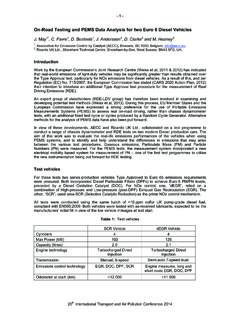Transcription of The latest EU directive on Electro - autoemc.net
1 The latest EU directive on Electro -Magnetic Compatibility Terry Beadman Mira Ltd Watling Street Nuneaton Warwickshire CV10 0TU. Tel: +44 (0) 247 6355495. Fax: +44 (0) 247 6358495. e-mail: web: Introduction EMC legislation for vehicles has changed from only being required to allow interference free TV and radio reception, to requirements that ensure the modern vehicle functions safely in the presence of radio transmitters. The correct application of 95/54/EC has made significant improvements in road safety but the difficulties of correctly applying to aftermarket parts, especially radio parts, have been recognized. The new directive attempts to remove the anomalies and to provide requirements appropriate for modern vehicles and their suppliers. The latest directive is reviewed and the relationship with other current EMC legislation, including 89/336/EEC is discussed.
2 Directives and Automotive EMC. The generic EMC directive , 89/336/EEC, was published in 1989, came into full effect on 1. January 1996 and applied to all electrical and electronic equipment. Article of 89/336/EEC. provides an exemption for apparatus covered by a product specific directive . Since 1972 the European automotive industry has had a relevant directive , 72/245/EEC, which covered the suppression of radio interference from spark ignition engines. To comply with 89/336/EEC the automotive industry initiated an amendment to 72/245/EEC to cover the EMC of motor vehicles. The automotive EMC directive 95/54/EC amended 72/245/EEC to provide harmonized EMC protection requirements for most vehicles of 4 wheels or more and all devices intended to be fitted to them. It ensures that vehicles operate safely in their electromagnetic environment and do not emit excessive levels of electromagnetic radiation.
3 Aftermarket equipment is included so that the essential requirements for vehicle type approval are not compromised. It is recognized that all EMC phenomena necessary for the in-vehicle EMC environment are not covered by 95/54/EC. Confusion has been caused by 95/54/EC stating that it is the sole EMC requirement for vehicle and devices intended for use in vehicles. The European Commission Guidance on 89/336/EEC and 95/54/EC was amended in May 2003 to specify that for EMC phenomena not covered by the automotive specific directive the requirements of 89/336/EEC for CE marking applied. The proposed new generic EMC. directive (replacing 89/336/EEC) states that This directive shall not apply to equipment or requirements in so far as the requirements laid down in this directive are harmonised by more specific Community legislation.
4 This would appear to match the guidance published for 89/336/EEC. 95/54/EC was written with the assumption that any devices fitted to a vehicle, including aftermarket parts, would be subject to the vehicle manufacturer's requirements for all EMC phenomena. In practice the vehicle manufacturer does not have this level of control on aftermarket parts. This confusion over approval is a problem that the European Commission guidance was published to address. Certainly it is recognized that aftermarket parts, which are only tested to the limited requirements of 95/54/EC, may have reliability problems for the end user. 95/54/EC was worded such that it could be interpreted that radio-transmitting equipment could only be installed if approved by the vehicle manufacturer. Understandably the European radio industry could not accept this interpretation by some countries.
5 They viewed it as a barrier to trade. There were meetings over a number of years between the industries as they attempted to come to an understanding for the application of 95/54/EC. At one time it was believed that an understanding had been reached on the key issue of how radio equipment could gain approval under 95/54/EC as aftermarket ESAs. The UK's Vehicle Approval Authority's interpretation had been published by the discussion group and had received favorable comment from the Commission. However by this time the European Commission had decided to fund an investigation into the problem. Eventually this was published as the York report. This lead the European Commission to insist on a re-write of 95/54/EC to include some of the key points from the York report. The industries worked together to draft a new directive and presented it to the Commission in 2002.
6 directive 2004/XX/EC was approved in the Committee for Adaptation to Technical Progress (CATP) in May this year. Publication in the Official Journal of the European Community is awaited. This agreement of the European governments took over a year to achieve after the vehicle industry and the radio industry agreed on the basic wording. A number of details have been amended or inserted to meet the views of the governments. The new directive has responded to the radio industry's complaint that some countries and some vehicle manufacturers were using 95/54/EC approvals as a barrier to trade, but it also gives the vehicle manufacturer the facility to place limits on radio use in their vehicles. This new directive recognizes the requirement for any aftermarket part to be CE marked and calls for this together with requirements on the tests required for some EMC phenomena as well as continuing to require automotive type approval for any device that may affect road safety.
7 This new directive has to be in national law by 31 December 2005 with type approval to it possible from 1 January 2006. New type vehicles and Electronic Sub-Assemblies are required to comply from 1 July 2006. However, existing types of vehicles and ESAs do not need to comply until 1 January 2009. The new automotive EMC directive At first sight this new directive seems similar to 95/54/EC. However when read carefully it shows a large number of changes both small and large, both administrative and technical. This paper discusses the ones that are of most importance. Immunity related functions Immunity related functions are defined in annex I paragraph They are grouped as: ?? functions relating to direct control, ?? functions related to driver, passenger and other road user protection, ?
8 ? functions which when disturbed cause confusion to the driver or other road user, ?? functions related to vehicle data bus functionality, ?? and functions which when disturbed affect vehicle statuary data. The details given for each of these is given as example it is expected that the Technical Service will be obliged to make a technical assessment and give a ruling on what is an immunity related function if it is not listed as one of the examples. CE and/or e . 95/54/EC stated: the technical requirements relating to the radio interference (electromagnetic compatibility) of vehicles, their components and systems should be governed from 1 January 1996 solely by the provisions of directive 72/245/EEC (as amended by 95/54/EC). 2004/XX/EC does not have this statement. This change matches the Commission's guidance on the relationship of 95/54/EC to 89/336/EEC: For new types of vehicles placed on the EEA market after 1/01/1996, new types of components and new types of separate technical units intended to be fitted into motor vehicles and placed on the EEA market after 1/01/1996, the specific directive 95/54/EC is mandatory.
9 These products must bear the 'e' marking that confers free movement throughout the EEA area. For the phenomena it doesn't cover, directive 89/336/EEC continues to apply, reason for which such products should also continue to carry the CE mark.. It can be argued that this does not mean that vehicles should be CE marked as they are exempted from this by the Machinery directive . However it is certainly reasonable to require this for aftermarket products and 2004/XX/EC recognizes this and allows for non-immunity related parts to be CE marked only, but subject to a Technical Service assessment to ensure road safety is not compromised. The document required from the Technical Service is defined in Annex IIIC. Interestingly it also requires a stamp of administration . Clarification is needed to resolve whether this is to be the authorisation mark of the Technical Service with the document being viewed as the opinion of the Technical Service, or the authorisation mark of the Approval Authority.
10 Certainly if the example of Notified Bodies is taken from CE marking directives it is reasonable for the Technical Service to authorize the document defined in Annex IIIC. This procedure is subject to review for necessity within 3 years from the directive entering into force. If it is discontinued it will be left to the competence of the aftermarket supplier to decide whether an ESA is immunity related. Only CE marking has the advantage for the supplier in that the vehicle type approval requirement for a formal Conformity of Production certification is no longer required. Test House accreditation The requirement for test work to be carried out by a test laboratory accredited to ISO 17025. and approved by the approval authority is now stated repeatedly in the directive . Each test annex specifies accreditation to the applicable parts of ISO 17025, but an opinion from UKAS ( the UK accreditation service) is that all parts are applicable for an accreditation to be awarded.













